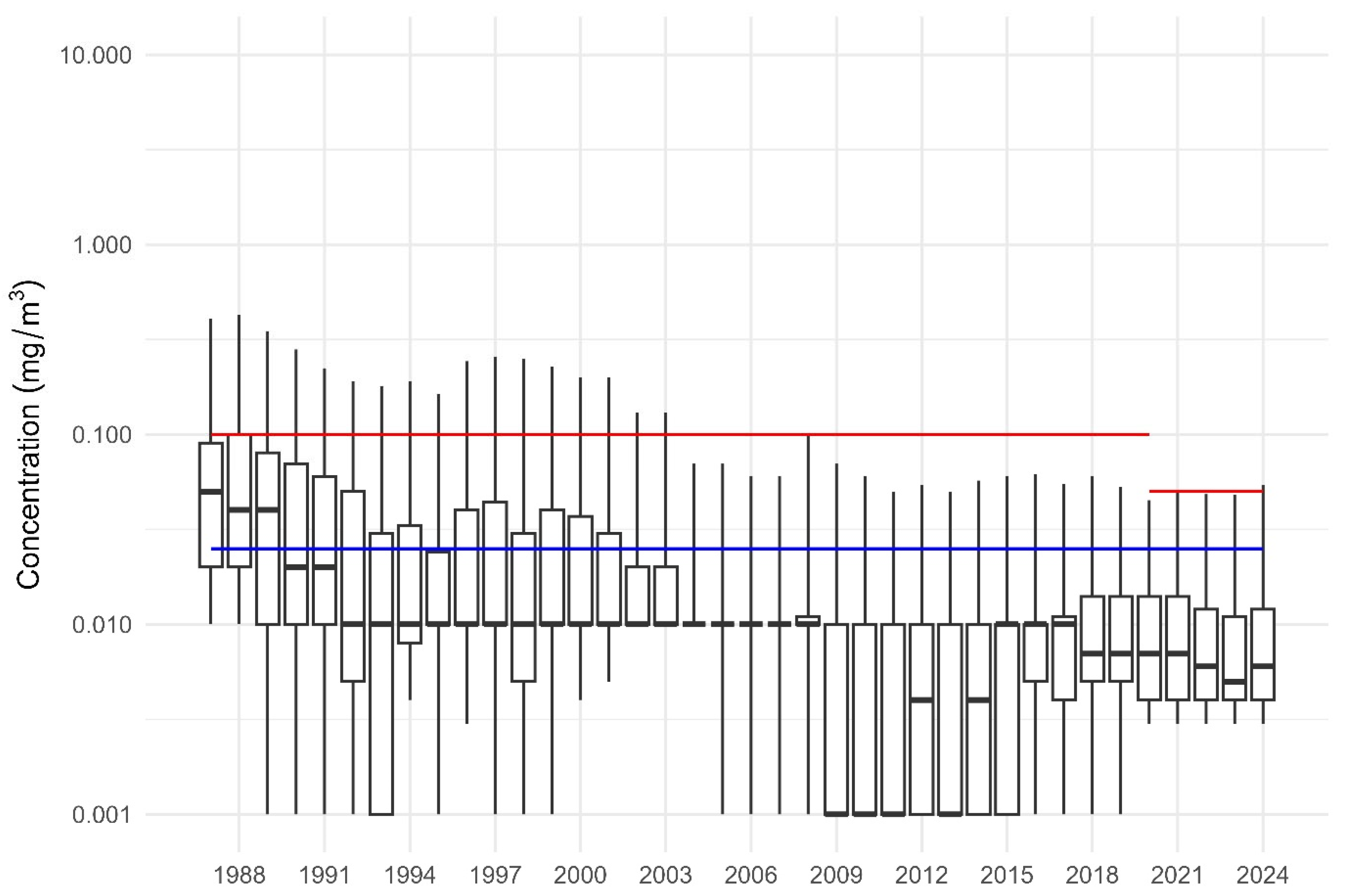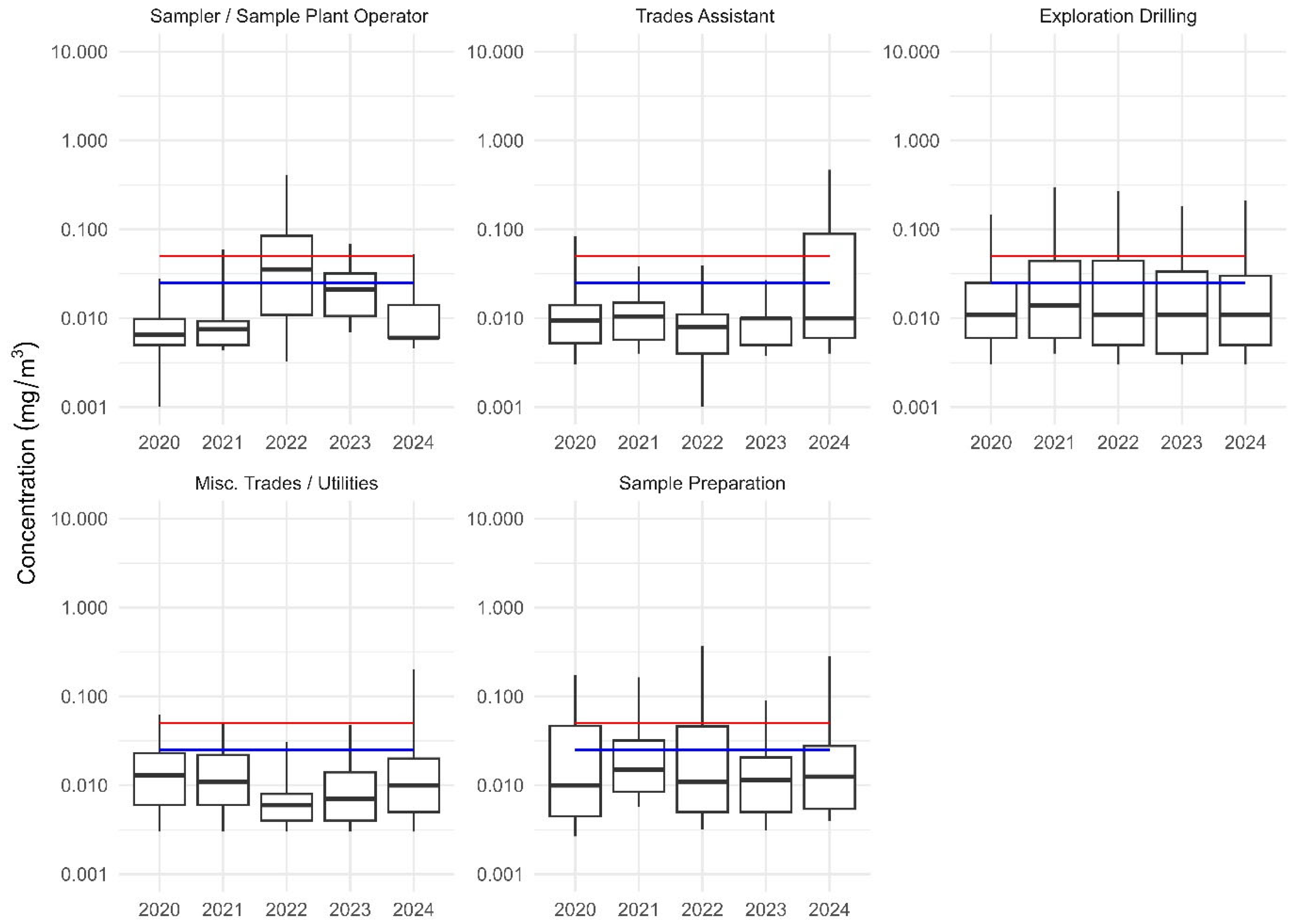Assessing Compliance with Evolving Exposure Standards: Respirable Crystalline Silica (RCS) Exposure in Western Australian Mining
Abstract
1. Introduction
- Trends in exposure: whether RCS exposures in the WA mining industry have decreased over time.
- Compliance with standards and the extent to which current exposures align with both existing and proposed exposure standards (workplace exposure standards and limits), and
- SEG-specific risks: whether certain similar exposure groups (SEGs) remain disproportionately exposed.
2. Materials and Methods
Limitations
3. Results
3.1. Compliance Trends over Time
3.2. Differences Between Occupational Groups
4. Discussion
4.1. Trends over Time
4.2. Compliance with Exposure Standards
4.3. SEG-Specific
5. Conclusions
Author Contributions
Funding
Institutional Review Board Statement
Informed Consent Statement
Data Availability Statement
Acknowledgments
Conflicts of Interest
References
- Alif, S.; Glass, D.; Abramson, M.; Hoy, R.; Sim, M. Occupational Lung Diseases in Australia 2006–2019; Safe Work Australia: Canberra, Australia, 2019; Available online: https://researchmgt.monash.edu/ws/portalfiles/portal/318554705/316502442_oa.pdf (accessed on 1 August 2025).
- Agency for Toxic Substances and Disease Registry. Toxicological Profile for Silica. 2019. Available online: https://wwwn.cdc.gov/TSP/ToxProfiles/ToxProfiles.aspx?id=1483&tid=290 (accessed on 1 August 2025).
- Leung, C.C.; Yu, I.T.; Chen, W. Silicosis. Lancet 2012, 379, 2008–2018. [Google Scholar] [CrossRef] [PubMed]
- Steenland, K.; Ward, E. Silica: A lung carcinogen. CA A Cancer J. Clin. 2014, 64, 63–69. [Google Scholar] [CrossRef] [PubMed]
- Rey-Brandariz, J.; Martínez, C.; Candal-Pedreira, C.; Pérez-Ríos, M.; Varela-Lema, L.; Ruano-Ravina, A. Occupational exposure to respirable crystalline silica and lung cancer: A systematic review of cut-off points. Environ. Health 2023, 22, 82. [Google Scholar] [CrossRef] [PubMed]
- Misra, S.; Sussell, A.L.; Wilson, S.E.; Poplin, G.S. Occupational exposure to respirable crystalline silica among US metal and nonmetal miners, 2000–2019. Am. J. Ind. Med. 2023, 66, 199–212. [Google Scholar] [CrossRef] [PubMed]
- Hoy, R.F.; Jeebhay, M.F.; Cavalin, C.; Chen, W.; Cohen, R.A.; Fireman, E.; Go, L.H.T.; León-Jiménez, A.; Menéndez-Navarro, A.; Ribeiro, M.; et al. Current global perspectives on silicosis—Convergence of old and newly emergent hazards. Respirology 2022, 27, 725–733. [Google Scholar] [CrossRef] [PubMed]
- Safe Work Australia. Working with Crystalline Silica Substances, Guidance for PCBUs; Safe Work Australia: Canberra, Australia, 2024. Available online: https://www.safeworkaustralia.gov.au/sites/default/files/2024-08/working-with-crystalline-silica-substances-guidance_aug2024.pdf (accessed on 2 August 2025).
- R Core Team. R: A Language and Environment for Statistical Computing; R Foundation for Statistical Computing: Vienna, Austria, 2024; Available online: https://www.R-project.org/ (accessed on 2 August 2025).
- Harman, A.W.; Foley, P.G.; Ralph, M.I. Silica exposures and silicosis incidence in the Western Australia mining industry. Occup. Med. 2025, 75, 227–234. [Google Scholar] [CrossRef] [PubMed]
- Wan, K.C.; Lee, E. Silicosis in Western Australia 1984–1993. In Proceedings of the National Health and Safety Commission National Scientific Forum on Crystalline Silica, Sydney, Australia, 9 November 1993. [Google Scholar]
- Safe Work Australia. New Workplace Exposure Limits (WEL) to Apply from 1 December 2026. 2024. Available online: https://www.safeworkaustralia.gov.au/media-centre/news/new-workplace-exposure-limits-wel-apply-1-december-2026 (accessed on 1 August 2025).
- Howlett, P.; Gan, J.; Lesosky, M.; Feary, J. Relationship between cumulative silica exposure and silicosis: A systematic review and dose-response meta-analysis. Thorax 2024, 79, 934–942. [Google Scholar] [CrossRef] [PubMed]
- de Klerk, N.H.; Ambrosini, G.L.; Pang, S.C.; Musk, A.W. Silicosis compensation in Western Australian in gold miners since the introduction of an occupational exposure standard for crystalline silica. Ann. Occup. Hyg. 2002, 46, 687–692. [Google Scholar] [CrossRef] [PubMed]
- Peters, S.; Vermeulen, R.; Fritschi, L.; Musk, A.; Reid, A.; de Klerk, N. Trends in exposure to respirable crystalline silica (1986–2014) in Australian mining. Am. J. Ind. Med. 2017, 60, 673–678. [Google Scholar] [CrossRef] [PubMed]


Disclaimer/Publisher’s Note: The statements, opinions and data contained in all publications are solely those of the individual author(s) and contributor(s) and not of MDPI and/or the editor(s). MDPI and/or the editor(s) disclaim responsibility for any injury to people or property resulting from any ideas, methods, instructions or products referred to in the content. |
© 2025 by the authors. Licensee MDPI, Basel, Switzerland. This article is an open access article distributed under the terms and conditions of the Creative Commons Attribution (CC BY) license (https://creativecommons.org/licenses/by/4.0/).
Share and Cite
Liebenberg, A.; Padamsey, K.; Staples, K.; Oosthuizen, M.; Cattani, M.; McCarthy, A.; Oosthuizen, J. Assessing Compliance with Evolving Exposure Standards: Respirable Crystalline Silica (RCS) Exposure in Western Australian Mining. Int. J. Environ. Res. Public Health 2025, 22, 1567. https://doi.org/10.3390/ijerph22101567
Liebenberg A, Padamsey K, Staples K, Oosthuizen M, Cattani M, McCarthy A, Oosthuizen J. Assessing Compliance with Evolving Exposure Standards: Respirable Crystalline Silica (RCS) Exposure in Western Australian Mining. International Journal of Environmental Research and Public Health. 2025; 22(10):1567. https://doi.org/10.3390/ijerph22101567
Chicago/Turabian StyleLiebenberg, Adelle, Kiam Padamsey, Kerry Staples, Matthew Oosthuizen, Marcus Cattani, Andy McCarthy, and Jacques Oosthuizen. 2025. "Assessing Compliance with Evolving Exposure Standards: Respirable Crystalline Silica (RCS) Exposure in Western Australian Mining" International Journal of Environmental Research and Public Health 22, no. 10: 1567. https://doi.org/10.3390/ijerph22101567
APA StyleLiebenberg, A., Padamsey, K., Staples, K., Oosthuizen, M., Cattani, M., McCarthy, A., & Oosthuizen, J. (2025). Assessing Compliance with Evolving Exposure Standards: Respirable Crystalline Silica (RCS) Exposure in Western Australian Mining. International Journal of Environmental Research and Public Health, 22(10), 1567. https://doi.org/10.3390/ijerph22101567









